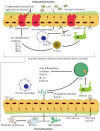The Anti-Inflammatory and Curative Exponent of Probiotics: A Comprehensive and Authentic Ingredient for the Sustained Functioning of Major Human Organs
- PMID: 38398870
- PMCID: PMC10893534
- DOI: 10.3390/nu16040546
The Anti-Inflammatory and Curative Exponent of Probiotics: A Comprehensive and Authentic Ingredient for the Sustained Functioning of Major Human Organs
Abstract
Several billion microorganisms reside in the gastrointestinal lumen, including viruses, bacteria, fungi, and yeast. Among them, probiotics were primarily used to cure digestive disorders such as intestinal infections and diarrhea; however, with a paradigm shift towards alleviating health through food, their importance is large. Moreover, recent studies have changed the perspective that probiotics prevent numerous ailments in the major organs. Probiotics primarily produce biologically active compounds targeting discommodious pathogens. This review demonstrates the implications of using probiotics from different genres to prevent and alleviate ailments in the primary human organs. The findings reveal that probiotics immediately activate anti-inflammatory mechanisms by producing anti-inflammatory cytokines such as interleukin (IL)-4, IL-10, IL-11, and IL-13, and hindering pro-inflammatory cytokines such as IL-1, IL-6, and TNF-α by involving regulatory T cells (Tregs) and T helper cells (Th cells). Several strains of Lactobacillus plantarum, Lactobacillus rhamnosus, Lactobacillus casei, Lactobacillus reuteri, Bifidobacterium longum, and Bifidobacterium breve have been listed among the probiotics that are excellent in alleviating various simple to complex ailments. Therefore, the importance of probiotics necessitates robust research to unveil the implications of probiotics, including the potency of strains, the optimal dosages, the combination of probiotics, their habitat in the host, the host response, and other pertinent factors.
Keywords: Bifidobacterium; Lactobacillus; gut microflora; inflammation; lactic acid bacteria; probiotics.
Conflict of interest statement
The authors declare no conflicts of interest.
Figures






Similar articles
-
A randomized double-blind placebo-controlled trial of probiotics in post-surgical colorectal cancer.BMC Gastroenterol. 2019 Jul 24;19(1):131. doi: 10.1186/s12876-019-1047-4. BMC Gastroenterol. 2019. PMID: 31340751 Free PMC article. Clinical Trial.
-
Live and heat-killed probiotic Lactobacillus casei Lbs2 protects from experimental colitis through Toll-like receptor 2-dependent induction of T-regulatory response.Int Immunopharmacol. 2016 Jul;36:39-50. doi: 10.1016/j.intimp.2016.03.033. Epub 2016 Apr 22. Int Immunopharmacol. 2016. PMID: 27107798
-
Comparative effects of six probiotic strains on immune function in vitro.Br J Nutr. 2012 Aug;108(3):459-70. doi: 10.1017/S0007114511005824. Epub 2011 Nov 7. Br J Nutr. 2012. PMID: 22054064
-
Probiotics for prevention and treatment of diarrhea.J Clin Gastroenterol. 2011 Nov;45 Suppl:S149-53. doi: 10.1097/MCG.0b013e3182257e98. J Clin Gastroenterol. 2011. PMID: 21992955 Review.
-
Efficacy of Using Probiotics with Antagonistic Activity against Pathogens of Wound Infections: An Integrative Review of Literature.Biomed Res Int. 2019 Dec 12;2019:7585486. doi: 10.1155/2019/7585486. eCollection 2019. Biomed Res Int. 2019. PMID: 31915703 Free PMC article. Review.
Cited by
-
Engineering Probiotics for Diabetes Management: Advances, Challenges, and Future Directions in Translational Microbiology.Int J Nanomedicine. 2024 Oct 28;19:10917-10940. doi: 10.2147/IJN.S492651. eCollection 2024. Int J Nanomedicine. 2024. PMID: 39493275 Free PMC article. Review.
-
Effects of a Novel Fortified Dairy Product on the Psychological Status and Sleep Quality of Patients with Polycystic Ovary Syndrome: A Double-Blind Randomized Controlled Trial.Prev Nutr Food Sci. 2025 Feb 28;30(1):37-46. doi: 10.3746/pnf.2025.30.1.37. Prev Nutr Food Sci. 2025. PMID: 40059915 Free PMC article.
-
Probiotics and nanoparticle-mediated nutrient delivery in the management of transfusion-supported diseases.Front Cell Infect Microbiol. 2025 Apr 11;15:1575798. doi: 10.3389/fcimb.2025.1575798. eCollection 2025. Front Cell Infect Microbiol. 2025. PMID: 40292219 Free PMC article. Review.
-
Gut Microbiota Secondary Metabolites: Key Roles in GI Tract Cancers and Infectious Diseases.Biomedicines. 2025 Jan 3;13(1):100. doi: 10.3390/biomedicines13010100. Biomedicines. 2025. PMID: 39857684 Free PMC article. Review.
-
The Role of Notch Signaling and Gut Microbiota in Autoinflammatory Diseases: Mechanisms and Future Views.Biomedicines. 2025 Mar 21;13(4):768. doi: 10.3390/biomedicines13040768. Biomedicines. 2025. PMID: 40299348 Free PMC article. Review.
References
Publication types
MeSH terms
Substances
LinkOut - more resources
Full Text Sources
Molecular Biology Databases

